Plus Two Chemistry Chapter Wise Questions and Answers Chapter 4 Chemical Kinetics are part of Plus Two Chemistry Chapter Wise Questions and Answers. Here we have given Plus Two Chemistry Chapter Wise Questions and Answers Chapter 4 Chemical Kinetics.
Kerala Plus Two Chemistry Chapter Wise Questions and Answers Chapter 4 Chemical Kinetics
Plus Two Chemistry Chemical Kinetics One Mark Questions and Answers
Question 1.
The rate of a reaction is expressed as
![]()
The reaction is
(a) 4A + B → 2C + 3D
(b) B + 3D → 4A + 2C
(c) A + B → C + D
(d) B + D → A + C
Answer:
(b) B + 3D → 4A + 2C
Question 2.
Order of a reaction can
(a) rational
(b) zero
(c) integer
(d) all the above
Answer:
(d) all the above
Question 3.
The unit of rate constant for a zero order reaction is.
(a) L s-1
(b) L mol-1 s-1
(c) mol L-1 s-1
(d) mol s-1
Answer:
(c) mol L-1 s-1
Question 4.
The expression for half-life period of a first order is ___________
Answer:
t1/2 =
Question 5.
A plot of log k vs helps to calculate
(a) Energy of activation
(b) Rate constant of the reaction
(c) Order of the reaction
(d) Energy of activation as well as the frequency factor.
Answer:
(d) Energy of activation as well as the frequency factor
Question 6.
When the initial concentration of the reactant in a reaction is doubled the half life period of the reaction gets halved. The order of the reaction is _____
Answer:
2
Question 7.
In first order reaction, the concentration of the reactant decreases from 0.6 M to 0.3 M in 30 minutes. The time taken for the concentration to change from 0.1 M to 0.25 M is
Answer:
60 minute
Question 8.
The rate constant of a first order reaction is doubled when the temperature is increased from 20°C to 25°C. How many times to rate constant will increase if the temperature is raised from 20°C to 40°C
Answer:
16
Question 9.
The unit mol L-1 s-1 is meant for the rate constant of the reaction having the order _____
Answer:
Zero
Question 10.
If the activation energy for the forward reaction is 150 kJ/mol and that of the reverse reaction is 260 kJ/ mol. What is the enthalpy change?
Answer:
110 kJ/mol
Plus Two Chemistry Chemical Kinetics Two Mark Questions and Answers
Question 1.
Explain a graphical method for the determination of activation energy.
Answer:
Activation energy can be determined graphically from the Ink vs 1/T graph. From the graph,
In k = ln(Ae-Ea/RT)
In k = In A + in e-Ea/RT
In k = In A + -Ea /RT
This is in the form of y = mx + c
When a graph is plotted between 1/T and ln k, a straight line is obtained.
Slope of the line = –Ea/R
Therefore, Ea = slope × R
Question 2.
Choose the correct answer. The equation for t1/2 of first-order reaction is
- t1/2 = 0.693/k
- t1/2 = [R]0/2k
Answer:
1. t1/2 = 0.693/k
Question 3.
In a Chemistry class, teacher asked to write the rate expressions for the reaction,
NO2 + CO → NO + CO2-
Student 1 wrote: Rate ∝ [NO1/2] [CO]
Student 2 wrote: Rate ∝ [NO1/2] [NO1/2]
- Which is correct?
- Justify your answer.
Answer:
- Student 2 is correct.
- In fact the reaction takes place in 2 steps. They are,

According to the law of chemical kinetics, the rate of a reaction is determined by the slowest step. Here step 1 is the slowest step i.e., rate-determining step. By the law of mass action, rate of a chemical reaction is directly proportional to the product of molar concentration of the reactants.
rate = k[NO2][NO2]= k[NO2]2
Question 4.
What do you mean by rate of a reaction? Explain the method for the determination of the rate of reaction.
Answer:
Rate of a chemical reaction is the amount of product formed in unit time or the amount of reactant that reacted in unit time.
Rate = dx/dt. Here dx represents the amount of the product formed in a small interval of time dt.
Question 5.
1. Mention the order of the following reactions:
- CH3COOC2H5 + H2O → CH3COOH + C2H5OH
- C12H22O11 + H2O → C6H12O6 + C6H12O6
2. Unit of the rate constant of a reaction depends on the order of the reaction. If the concentration is expressed in mol/L and time in second. Find the unit of k for zero, first and second-order reactions.
Answer:
1. Order of the reactions:
- Pseudo 1st order
- Pseudo 1st order
2. Zero order = L-1 mol1 s-1
1st order = s-1
2nd order = L mol-1 s-1
Question 6.
Match the following:
| Type of reaction | Order |
| Photochemical | 3 |
| Nuclear reaction | 2 |
| 2NO + O2 → 2NO2 | 1 |
| N2 + O2 → 2NO | 0 |
Answer:
| Type of reaction | Order |
| Photochemical | 0 |
| Nuclear reaction | 1 |
| 2NO + O2 → 2NO2 | 3 |
| N2 + O2 → 2NO | 2 |
Question 7.
Mention the factors that affect the rate of a chemical reaction.
Answer:
The various factors that affect the rate of a chemical reaction are:
- Concentration of reactants
- Temperature of reaction
- Presence of catalyst
- Nature of reactants
- Surface area
- Exposure to radiation
Plus Two Chemistry Chemical Kinetics Three Mark Questions and Answers
Question 1.
Derive the expression for the half-life of a chemical reaction of first order?
Answer:
For a first order reaction,
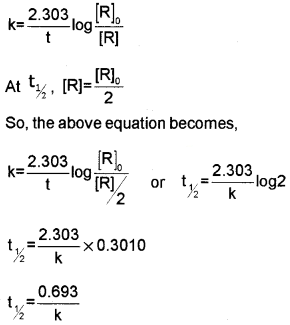
Thus, for a first order reaction, half-life period is constant, i.e., it is independent of initial concentration of the reacting species.
Question 2.
Say True or False.
- The rate of the reaction NO2 + CO → NO + CO2 can be written as a rate a [NO2]1 [CO]1.
- The reaction NO2 + CO → NO + CO2 takes place through one step.
- If a reaction takes place through more than two steps, the rate of the reaction is determined by the slowest step.
Answer:
- False
- False
- True
Question 3.
The rate of a chemical reaction is influenced by many factors.
- Write any five factors influencing rate of a reaction.
- Write a short note about temperature dependence of rate of a reaction.
Answer:
- Nature of the reactants, concentration of the reactants, temperature, pressure, catalyst, surface area, influence of radiation.
- Usually the rate of chemical reaction increases when the temperature increases. The rate of a chemical reaction is found to be twice that of the original value for every 10° raise of temperature.
Question 4.
Consider the statement: “Sum of average kinetic energy and activation energy is equal to threshold energy”.
- Is this correct?
- Define activation energy.
- Name the two methods used to determine the activation energy.
Answer:
- Yes.
- The excess amount of energy that is to be given to the reactant molecules in order to involve in a chemical reaction is called activation energy.
- Theoretical method and graphical method.
Question 5.
“Nuclear reactions are first order reactions.”
- Do you agree?
- What do you mean by order of a reaction?
- Write two differences between order and molecularity.
Answer:
- Yes.
- Order of a chemical reaction is the sum of the powers of the concentration terms which occur in the rate expression.
- Two differences between order and molecularity:
- Order: Experimental, can be zero.
- Molecularity: Theoretical, cannot be zero.
Question 6.
Analyse the statements:
Statement 1: “Half life of every reactions depend upon the initial amount.’’
Statement 2: “Half life depends on the initial amount except in the case of first order reactions.”
- Which statement is correct?
- Give the expressions for half life of a first order reaction. State how it is related to the initial concentration.
- Show that t1/2 of zero order reaction depends on initial amount?
Answer:
1. Statement 2.
2. t1/2 =
t1/2 of a first order reaction is independent of the initial concentration of the reacting species.
3. For a zero order reaction,

Where [R]0 is the initial amount.
i.e., t1/2 of zero order reaction is directly proportional to the initial amount.
Question 7.
A relation is given below. Answer the following questions.
Average kinetic energy + Activation energy = Threshold energy
- Explain Average Kinetic Energy, Activation Energy, and Threshold Energy.
- Give the equation showing the relation between rate constant and temperature and explain the terms.
- Name the above equation.
Answer:
1. Average kinetic Energy – The energy possessed by the reactant molecules which are involved in a chemical reaction.
Threshold energy – The minimum amount of energy required for the reactant molecules in order to involve in a chemical reaction.
Activation Energy – The excess amount of energy that is to be given to the reactant molecules in order to involve in a chemical reaction.
2. k = A e-Ea/RT
- A → constant (frequency factor)
- T → Temperature in Kelvin
- Ea → Activation energy
- K → Rate constant
3. Arrhenius equation.
Question 8.
Inversion of sucrose in presence of dilute acid is said to be pseudo-first-order reaction.
- Why is it said to be so?
- Give another example of pseudo order reaction.
Answer:
1.
![]()
The rate depends only on the concentration of sucrose and it is independent of the concentration of water. Thus, the reaction appears to be of second order but actually follows first order kinetics,
2. Hydrolysis of ester in presence of acid.
![]()
Question 9.
For a reaction A + B → C + D, the rate equation is given by, r = k[A] [B],
- What is the order of the above reaction?
- Find the unit of k in the above rate equation.
- What happens to the order of the reaction if‘B’is taken in large excess?
Answer:
- 2nd order
- L mol-1s-1
- If B is taken in large excess, the reaction behaves as 1st order reaction. Such reactions are called pseudo 1st order reactions.
Question 10.
For a reaction A → P, the rate of the reaction doubles when the concentration of A is increased by two times.
- Determine the order of the reaction.
- Derive an expression to determine the 14th life period of above order reaction.
Answer:
- First order reaction.
- 1/4th life of a first order reaction can be determined as follows.
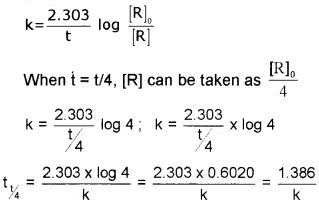
Question 11.
Fora reaction A + B → products, the rate equation is given as rate = k[A]1/2 [B]2
- What is the order of the above reaction?
- Distinguish between order and molecularity.
Answer:
1. Order of the reaction =
2.
| Molecularity | Order |
| 1. Experimental | 1. Theoretical |
| 2. Can be zero | 2. Can not be zero |
| 3. Can be a fraction | 3. Cannot be a fraction |
| 4. No.of reacting species taking part in an elementary reaction, which must collide simultaneously to bring about a chemical reaction | 4. Sum of the powers of the concentration of the reactants in the rate law expression |
Question 12.
For the reaction:
2A + B → A2B
the rate = k[A][B]2 with k = 2.0 × 10-6 mol-2 L2 s-1. Calculate the initial rate of the reaction when [A] = 0.1 mol L-1 [B] = 0.2 mol L-1. Calculate the rate of reaction after [A] is reduced to 0.06 mol L-1.
Answer:
Initial rate = k[A][B]2
But [A] = 0.1 M, [B] = 0.2 M and
k = 2.0 × 10-6 mol-2 L2 s-1
∴ Initial rate
= 2.0 × 10-6 mol-2 L2 s-1 × 0.1 M × (0.2 M)2
= 8 × 10-9 M s-1
From the equation 2A + B → A2B it is clear that when 2 moles of A are used then 1 mol of B is used in the same time. Therefore, when A has been reduced to 0.06 M , 0.04 M of A and hence 0.02 M of B have reacted. Thus,
Concentration of A left = [A] = 0.06 M
Concentration of B left = [B] = (0.2 M – 0.02 M) = 0.18 M
Rate = k[A][B]2
= 2.0 × 10-6 mol-2 L2 s-1 × 0.06M × (0.18 M)2
= 3.89 × 10-9M s-1
Question 13.
The decomposition of NH3 on platinum surface is zero order reaction. What are the rates of production of N2 and H2 if k = 2.5 × 10-4 mol-1 L s-1?
Answer:
The decomposition of NH3 is
2NH3 → N2 + 3H2
Rate of reaction,
![]()
where k is the rate constant. Since, reaction is of zero order,
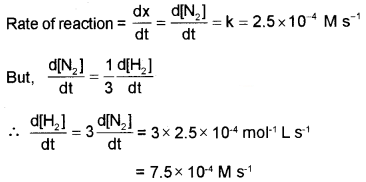
Question 14.
The rate constant of a first order reaction is 60 s-1. How much time will it take to reduce the initial concentration of the reactant to its 1/16th value?
Answer:
Rate constant of reaction, k = 60 s-1
t15/16 = ?
Rate constant of first order reaction is given as,
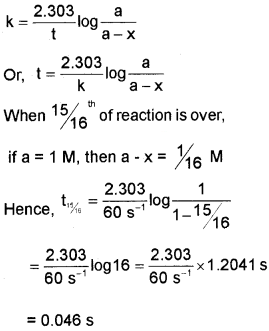
Question 15.
The rate of a reaction quadruples when the temperature changes from 293 K to 313 K. Calculate the energy of activation of the reaction assuming that it does not change with temperature.
Answer:
T1 = 293K, T2 = 313K
According to Arrhenius equation,
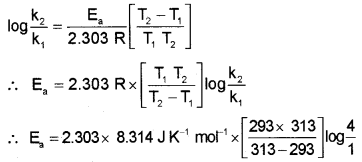
2.303 × 8.314 J K-1 mol-1 × 4585.45 K × 0.6021
= 52863.33 J mol-1 = 52.86 kJ mol-1
Plus Two Chemistry Chemical Kinetics Four Mark Questions and Answers
Question 1.
![]()
- Which type of the reaction is this?
- Write the order and molecularity of the reaction.
- What is the unit of rate constant?
- Write the 3 steps involved in this reaction?
Answer:
- Photochemical reaction
- Order = 0 Molecularity = 2
- L-1 mol1 sec-1
- Initiation, propagation, termination
Question 2.
K = Ae-Ea/RT
- Write the name of this equation.
- What do you mean by Ea?
- Draw the graph between 1/T and Ink.
- Write the significance of k.
Answer:
1. Arrhenius equation.
2. The excess amount of energy that is to be given to the reactant molecules in order to involve in a chemical reaction is called activation energy (Ea)
3.
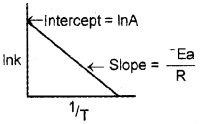
4. By noting the value of k, we can predict the speed of a chemical reaction. In the case of a fast reaction, the value of k is high and in the case of a slow reaction value of k is small. By noting the unit of rate constant, we can predict the order of chemical reaction.
Question 3.
Match the following:
| First order reaction | 2NO + O2 → 2NO2 |
| Second order reaction | CH3CHO → CH4 + CO |
| Third order reaction | Photochemical |
| 11/2 order reaction | N2 + O2 → 2NO |
| Zero order reaction | H2O → 2H2O + 1/2O2 |
Answer:
| First order reaction | H2O2 → H2O + 1/2O2 |
| Second order reaction | N2 + O2 → 2NO |
| Third order reaction | 2NO + O2 → 2NO2 |
| 11/2 order reaction | CH3CHO → CH4 + CO |
| Zero order reaction | Photochemical |
Question 4.
Consider the reaction
![]()
Answer the following questions
- Write down 2 steps through which the reaction takes place.
- Find out the slowest step.
- Which is the rate-determining step?
- Find out the order of the reaction.
Answer:
1. 2H2O2 + I– → H2O + IO–
H2O2 + IO– → H2O + I– + O2
2. 2H2O2 + I– → H2O + IO–
3. 2H2O2 + I– → H2O + IO–
4. Order = 2
Question 5.
A chemical reaction is conducted within two hours. But after one hour half of the product is obtained.
- Name the term used to designate this time?
- Give the expression for this term if it is a first order reaction.
- Calculate the rate constant of the above reaction.
Answer:
- Half life of a chemical reaction.
- t1/2 =
- k = = 0.693 hr-1
Question 6.
- Define half-life period of a reaction.
- A first order reaction is found to have a rate constant k = 5.5 × 10-14 s-1. Find the half-life period of the reaction.
Answer:
1. Time in which the concentration of the reactant is reduced to one half of its initial concentration.
2.
![]()
Question 7.
Order of a reaction is an experimental quantity.
(1) Calculate the overall order of a reaction which has the rate expression:
a) Rate = k[A]1/2[B]3/2
b) Rate = k[A]3/2[B]-1
(2) The initial concentration of N2O5 in the following first order reaction N2O6 (g) → 2NO2(g) + 1/2 O2(g) was 1.24 × 10-2 mol/L at 318 K.
The concentration of N2O5, after 60 min was 0.20 × 10-2 mol/L. Calculate the rate constant of the reaction at 318 K.
Answer:
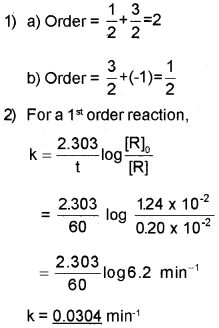
Question 8.
1. Write the rate expression for the following reaction.
2N2O5(g) → 4NO2(g) + O2(g)
2. For a hypothetical reaction, aX + bY → Products, the rate law is given as = k[X]2[Y]1/2. What happens to the rate of the reaction when
- The concentration of ‘X’ is doubled keeping that of ‘Y’ constant.
- The concentration of both ‘Y’ is doubled keeping that of ‘X’ constant.
Answer:
1. Rate expression:
![]()
2.
- Increases by 4 times
- Increases by times.
Question 9.
1. Identify the reaction order.
- k= 2.3 × 10-5 L/mol/s
- k= 3 × 10-4 s-1
2. Calculate the activation energy. The rate constants of a reaction are 1 × 10-3 s-1 and 2 × 10-3 s-1 at 30°C and 40°C respectively.
Answer:
1. The reaction order:
- Second order
- First order
2.
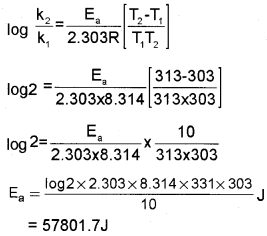
Question 10.
For a reaction A + B → Product, the rate law is given by r= k[A] [B],
- What is the order of the reaction?
- What will be the effect of temperature on rate constant?
- Can activation energy for reactions be zero? Justify your answer.
Answer:
1. Order is the sum of the powers of the concentration terms in the rate law.
rate = K [A]x [B]y
∴ Order = x + y
2. According to Arrhenius equation, at a particular temperature for a definite value of activation energy, rate constant,
k ∝ e-1/T
3. If average kinetic energy of reactant molecule is equal to threshold energy, then activation energy can be zero.
Plus Two Chemistry Chemical Kinetics NCERT Questions and Answers
Question 1.
For the reaction:
2A + B → A2B
the rate = k[A][B]2 with k = 2.0 × 10-6 mol-2 L2 s-1. Calculate the initial rate of the reaction when [A] = 0.1 mol L-1 [B] = 0.2 mol L-1. Calculate the rate of reaction after [A] is reduced to 0.06 mol L-1.
Answer:
Initial rate = k[A][B]2
But [A] = 0.1 M, [B] = 0.2 M and
k = 2.0 × 10-6 mol-2 L2 s-1
Initial rate
= 2.0 × 10-6 mol-2 L2 s-1 × 0.1 M × (0.2 M)2
= 8 × 10-9 M s-1
From the equation 2A + B → A2B it is clear that when 2 moles of A are used then 1 mol of B is used in the same time. Therefore, when A has been reduced to 0.06 M , 0.04 M of A and hence 0.02 M of B have reacted. Thus,
Concentration of A left = [A] = 0.06 M.
Concentration of B left = [B] = (0.2 M – 0.02 M) = 0.18 M
Rate = k[A][B]2
= 2.0 × 10-6 mol-2 L2 s-1 × 0.06M × (0.18 M)2
= 3.89 × 10-9M s-1
Question 2.
Mention the factors that affect the rate of a chemical reaction.
Answer:
The various factors that affect the rate of a chemical reaction are:
- Concentration of reactants
- Temperature of reaction
- Presence of catalyst
- Nature of reactants
- Surface area
- Exposure to radiation
Question 3.
The decomposition of NH3 on platinum surface is zero order reaction. What are the rates of production of N2 and H2 if k = 2.5 × 10-4 mol-1 L s-1?
Answer:
The decomposition of NH3 is
2NH3 → N2 + 3H2
Rate of reaction,
![]()
where k is the rate constant. Since, reaction is of zero order,
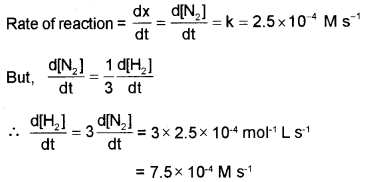
Question 4.
The rate constant of a first order reaction is 60 s-1. How much time will it take to reduce the initial concentration of the reactant to its 1/16th value?
Answer:
Rate constant of reaction, k = 60 s-1
t15/16 = ?
Rate constant of first order reaction is given as,

Question 5.
The rate of a reaction quadruples when the temperature changes from 293 K to 313 K. Calculate the energy of activation of the reaction assuming that it does not change with temperature.
Answer:
T1 = 293K, T2 = 313K
According to Arrhenius equation,
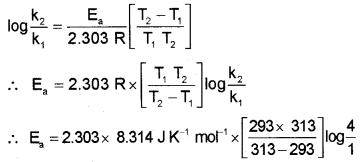
2.303 × 8.314 J K-1 mol-1 × 4585.45 K × 0.6021
= 52863.33 J mol-1 = 52.86 kJ mol-1
We hope the given Plus Two Chemistry Chapter Wise Questions and Answers Chapter 4 Chemical Kinetics will help you. If you have any query regarding Plus Two Chemistry Chapter Wise Questions and Answers Chapter 4 Chemical Kinetics, drop a comment below and we will get back to you at the earliest.
